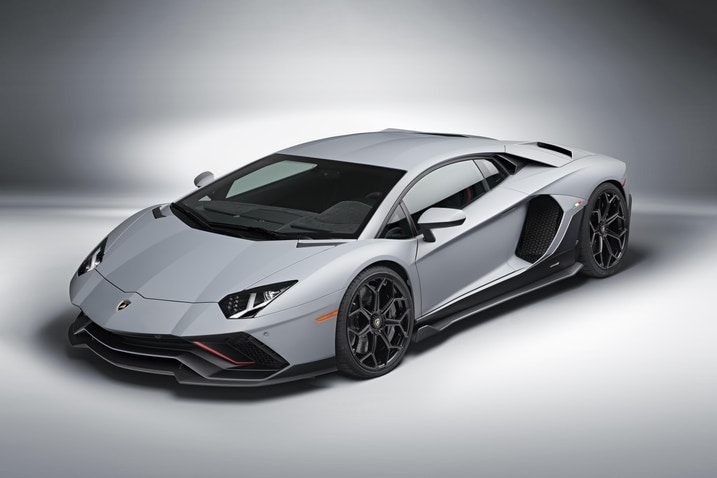- Codenamed "LB744," this mid-engine hybrid is the successor to the outgoing Aventador.
- This mechanical teaser shows the layout of the LB744's 6.5-liter V12, three electric motors, eight-speed gearbox and centrally mounted battery pack.
- Lamborghini says the combined output of the powertrain is approximately 1,000 horsepower.
- In celebration of its 60th anniversary, Lamborghini plans to reveal its range-topping hybrid supercar later this year.
Lamborghini Teases 1,000-HP Hybrid Powertrain for Aventador Successor
With three electric motors and all-wheel drive, Lamborghini's successor to the mighty Aventador is a mid-engine masterpiece
It's not easy trying to outdo a vehicle as outrageously quick and otherworldly in appearance as the mid-engine Lamborghini Aventador supercar. Yet that's the task facing Lamborghini and, from these first images and specs of Aventador's successor, codenamed "LB744," it seems the challenge to outdo its flagship of the last decade was met with open arms by the automaker's engineering team in Sant'Agata, Italy.
One technical feature similar to the outgoing Aventador is the placement of a gas-fed 6.5-liter V12 engine directly behind the two-passenger cabin. Except here in the LB744, the V12 has done a complete 180-degree turn, with the transmission now positioned at the rear of the vehicle. In what would once have filled the transmission tunnel, Lamborghini has now cleverly installed a 3.8-kWh lithium-ion battery pack.
According to Lamborghini, when it's plugged into an outlet it takes about 30 minutes to recharge the battery at up to 7 kW. Or, when it's using regenerative braking from the front wheels or employing the V12 engine itself, Lamborghini says the same recharge is accomplished in only six minutes.
Before zeroing in on the three electric motors and the new eight-speed dual-clutch automatic, it's worth pointing out the fine-tuning Lamborghini has put into the V12. At 481 pounds, it has shed around 37 pounds compared to its previous implementation in the Aventador. It's also more powerful thanks to refinements made to the air intake ducts, optimization of the combustion chambers, and improved fluid dynamics of the exhaust. In other words, lots of fancy engine work went into this screaming V12. The result is 814 horsepower at 9,250 rpm and 535 lb-ft of torque at 6,750 rpm.
Complementing this monster are three electric motors, two mounted at the front axle with each one individually powering its own given wheel. The third resides above the eight-speed transmission that's located behind the V12. This motor is capable of powering the rear wheels "depending on the selected drive mode and the conditions," according to Lamborghini. The total output of the V12 and electric motors is about 1,000 horsepower and 793 lb-ft of torque per Lamborghini.
The front electric motors feature torque vectoring to route power exactly where it's needed, along with regenerative braking to feed energy back to the battery pack. Interestingly, when driving solely on electric power, the LB744 reverts to a front-wheel-drive configuration to conserve energy. (The same is true when in reverse, as the transmission has no reverse gear.) Adding electric power to the rear wheels is possible on demand, however.
For the moment, Lamborghini has not mentioned how long the car's all-electric range might be, though the automaker said overall carbon emissions are lower compared to the Aventador Ultimae (seen above).
Last but certainly not least, the eight-speed dual-clutch gearbox used in the LB744 will find its way into Lamborghini's next generation of super sports cars. Tipping the scales at 425 pounds, it's designed to be compact and its placement behind the V12 helps free up cabin room. It will also likely be a notable improvement over the Aventador's famously clunky ISR single-clutch automated manual gearbox. Lamborghini also says this new wet double-clutch transmission is both lighter and clicks through gears faster than the seven-speed dual-clutch gearbox used in the current Huracán.
Look for Lamborghini's first-ever "High Performance Electrified Vehicle" (HPEV) to make a splashy debut later this year. As for a potential price, keep in mind the Aventador started around $400,000, and we don't expect its replacement to be any less expensive.
Edmunds says
Just because it's greener, don't be fooled into thinking the LB744, Lamborghini's hybrid-powered successor to the Aventador, is going to be any less meaner.







 by
by